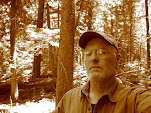Occasionally, I have met up with other canoe enthusiasts. It doesn't happen very often, and perhaps I don't get invited back. I noticed on my own that I don't quite fit in. While we share interests, we seem to be looking for something different, the shared experiences seem to be digested for some different goal. Usually, the others want to talk about their canoe collections or futz with paddles. Sometimes though, someone leads off to explore some odd nook, and I do enjoy watching another canoeist when they are "on the path."
So, today I checked out of a canoe chat group that I've been in for a few years. There were definitely some experts in the group and tips on repairing canoes or places to visit were useful. But, there were a handful of nitpickers that had to be ignored all too often. And all too often the threads would get hijacked so that one of the goofballs could talk about his guns. Gun discussions with respect to canoeing are only be relevant if one is planning to canoe in the far north where one might encounter grizzlies or polar bears. It's just dumb to be packing a gun for canoeing in the lower 48 or the lower half of Canada.
I put in at O'Sullivan's Island under sunny skies. The temperature was in the 50's and the tide was still rising. There was a light north wind. The first bird that I saw was an immature Bald Eagle. It took a perch on the far side of the river. In a few more yards of paddling, I was alerted to another by the chirpy whistle of an overhead Eagle. A mature Bald Eagle too wing from above and headed down river. It made 4 or 5 short flights in this manner before letting me pass. I circled Crescent Island, which is a bit over 3 miles downstream, and returned. I paddled the windier left bank on the return because it was brightly lit with red and orange maple tree leaves and red-brown sycamore foliage.



































